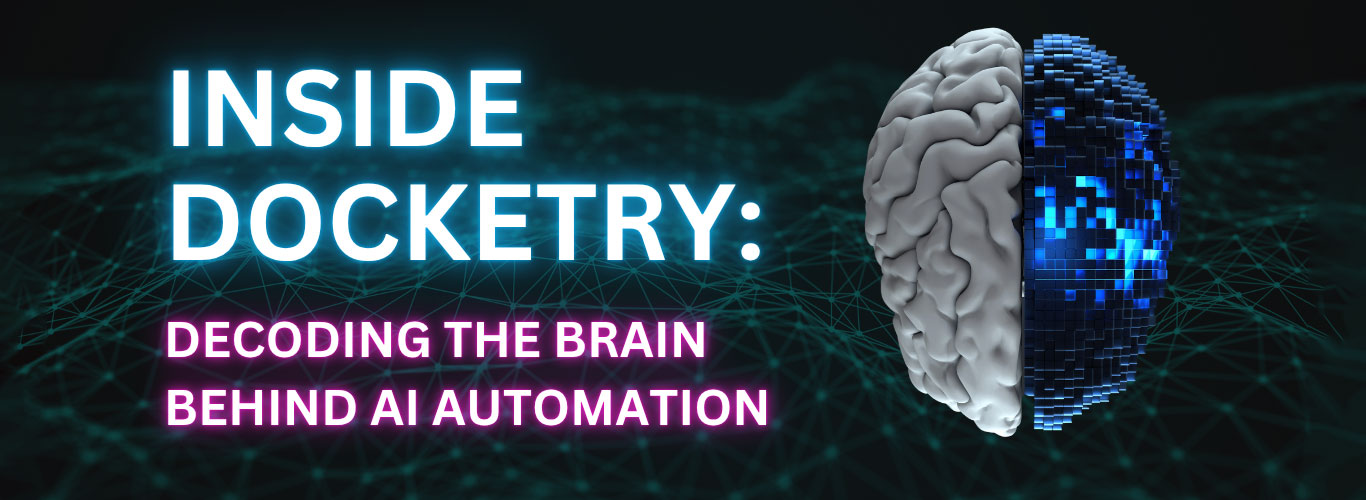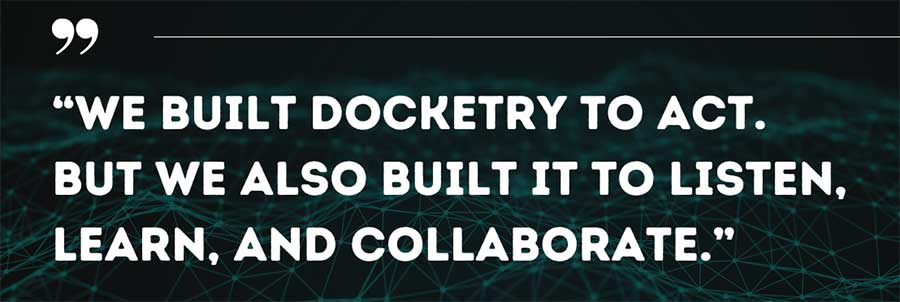Inside Docketry: How Agentic AI Is Becoming the Brain of Enterprise Automation
A CEO’s lens on how true intelligence emerges inside enterprise ops.
I once sat in a room with over 12 people manually reviewing data to understand why a mission-critical job failed.
We had dashboards. Logs. Alerts. And still, it felt like we were solving a murder mystery, scrambling through telemetry, debating root causes, chasing dead ends.
We didn’t need more eyes. We needed an intelligent agent with a brain.
Something that could connect the dots, understand what mattered, and act, without human intervention.
Docketry was born for situations and errors like this.
Not as another automation tool. But as something more ambitious:
An intelligent operating core that could run like your best engineer!
The Problem with Most Automation? It Doesn’t Think.
Today, automation is everywhere. But intelligence? That’s still rare.
Most tools follow instructions. They don’t reason. They react to triggers, not intentions.
They can tell you what happened. But they rarely understand why it matters, or what should be done next.
Enterprises don’t collapse because they missed an alert. They fail because they couldn’t connect that alert to business impact in time.
“The question isn’t whether your systems can act faster. It’s whether they know why they’re acting, and if they should.”
That’s why we built Docketry not as an execution engine, but as a cognitive one.
Something that observes, correlates, prioritizes, and decides, like a human expert. Just faster. And without bias.
What Makes Docketry ‘Agentic’?
This isn’t playbook automation. It’s agentic automation.
That means it doesn’t wait to be told what to do. It knows what it’s trying to achieve.
Docketry is goal-aware. It absorbs real-time telemetry, maps system dependencies, weighs urgency, and simulates downstream impact.
And when something shifts, it responds, not just by firing scripts, but by recalibrating its actions to meet business goals.
That’s possible because of the intelligent layers woven into the platform.
OpsIQ, our operations agent, constantly listens to the hum of your enterprise, distilling confusion into context. It doesn’t just flag anomalies; it connects them to workflows, owners, SLAs, and timelines. It helps Docketry act with precision, not panic.
Meanwhile, ExtractIQ, our document intelligence layer, surfaces the kind of operational wisdom that lives in PDFs, policies, and tribal knowledge, feeding that into every decision.
And when action requires conversation, when the system needs to interact with a human, explain its reasoning, or ask for approval, CASIE, our conversational agent, steps in.
It doesn’t just respond. It explains. It aligns humans and systems in real time.
This trio, perception through OpsIQ, institutional memory via extratIQ, and communication via CASIE, forms the cognitive loop that defines agentic automation. It’s not just a system that acts. It’s a system that reasons, decides, and justifies.
Decision-Making at the Speed of Relevance
Here’s where it gets powerful.
Traditional ops tools flood you with noise.
Docketry gives you decisions.
Because when the system understands context, what’s normal, what’s urgent, what’s strategic, it doesn’t need humans to babysit every incident.
It suppresses the noise. It assembles the narrative. And it acts.
Most systems escalate because they can’t prioritize. Docketry doesn’t just reduce alerts, it replaces them with judgment.
That’s what it means to operate at the speed of relevance, not reaction.
The Enterprise Brain Is Already Learning
Here’s the thing most platforms won’t tell you: automation isn’t enough.
If it doesn’t learn, it eventually breaks.
Docketry’s learning loop goes far beyond logs.
It adapts to how your teams actually think, what they override, what they escalate, what they ignore.
Every decision. Every conversation. Every exception, feeds the system’s evolving intelligence.
CASIE plays a key role here. It’s not just chat, it’s conversational memory. It logs how teams interact with ops, what questions they ask, what actions they approve or reject.
That’s critical data.
This memory allows the system to identify recurring friction points, anticipate decision bottlenecks, and improve autonomously over time.
Docketry isn’t static. It becomes more “you” every day.
“It’s not just automation that learns.
It’s automation that adapts to your DNA.
That’s what makes it sustainable.”
Why This Matters to C-Level Leaders
This isn’t about reducing headcount.
It’s about scaling judgment.
You don’t want more dashboards. You want fewer midnight decisions.
Docketry gives you confidence that when something goes wrong, the system already knows how to respond, or when to escalate for the right reasons.
But more importantly, agentic platforms like Docketry change how you lead. You stop managing exceptions. You start designing systems that self-regulate.
You get:
- Higher availability with fewer interventions
- Faster resolution without more personnel
- Compliance without process fatigue
And most critically, you gain trust in automation. Not because it’s perfect, but because it’s explainable.
“If your organization still needs humans in the loop for every exception,
you haven’t automated.
You’ve just outsourced thinking.”
This is what agentic AI really delivers: decision autonomy with business alignment.
Let the Brain Run the Body
Modern enterprises aren’t failing because of lack of data.
They’re failing because of decision paralysis.
Too many signals. Too little clarity.
Docketry changes that.
It doesn’t sit on top of your stack, it sits at the center. The cognitive core that ties systems to outcomes, action to intent.
With OpsIQ as its ears, ExtractIQ as its long-term memory, and CASIE as its voice, Docketry does more than automate.
It thinks.
It collaborates.
And soon, it will negotiate, with other systems, with other agents, with regulators. That’s the next chapter of agentic operations: AI coordinating with AI, on your behalf.
“We don’t automate to cut people.
We automate to let people do what only they can.”
If you’re ready to give your enterprise a brain,
let’s have that conversation.






